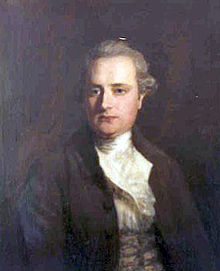Evan Nepean
Sir Evan Nepean | |
|---|---|
 | |
| Governor of Bombay | |
| In office 1812–1819 | |
| Preceded by | George Brown |
| Succeeded by | Mountstuart Elphinstone |
| Personal details | |
| Born | 9 July 1752 St Stephens by Saltash, Cornwall, England |
| Died | 2 October 1822 (aged 70) Loders, Dorset, England |
| Spouse | Margaret Skinner |
| Children | 8, including Charles Nepean |
| Parent | Nicholas Nepean |
| Occupation | Politician, Colonial administrator. |
Sir Evan Nepean, 1st Baronet, PC FRS (9 July 1752 – 2 October 1822)[1] was a British politician and colonial administrator. He was the first of the Nepean Baronets.
Family
Nepean was born at St. Stephens near Saltash, Cornwall, the second of three sons of Nicholas Nepean, an innkeeper, and his second wife, Margaret Jones. His father was Cornish and his mother was from South Wales.[1] The name "Nepean" is thought to come from the village of Nanpean ("the head of the valley"), in Cornwall.
Nepean married Margaret Skinner, the only daughter of Capt. William Skinner, on 6 June 1782 at the Garrison Church at Greenwich. They had eight children,[1] including Sir Molyneux Hyde Nepean, 2nd Bt., and Maj.-Gen. William Nepean, whose daughter Anna Maria Nepean married General Sir William Parke. Their youngest child, Rev. Canon Evan Nepean, became the Canon of Westminster and a Chaplain in Ordinary to Queen Victoria. His son Charles was a Middlesex county cricketer who also played football.[2] Other descendants of Nepean include actors Hugh Grant (born 1960) and Thomas Brodie-Sangster (born 1990), who by chance both appeared in the same film, Love Actually.[3]
Career
Nepean entered the Royal Navy on 28 December 1773, serving on HMS Boyne as a clerk to Capt. Hartwell. He was promoted to purser in 1775. During the American Revolutionary War he served as secretary to Admiral Molyneux Shuldham, in Boston in 1776 and again at Plymouth (1777–78). From 1780 to 1782 he was Purser on HMS Foudroyant for Captain John Jervis (later Lord St. Vincent).[1]
On 3 March 1782 (aged only 29) he was appointed Permanent Under-Secretary of State for the Home Department. In this position, he came to have responsibility for naval and political intelligence which led to him running a network of spies across Europe. [4] He served there until December 1791, when he became Under-Secretary of State for War in 1794, Secretary to the Board of Admiralty 1795–1804, Chief Secretary for Ireland 1804–1805, Commissioner of the Admiralty, and then Governor of Bombay 1812–1819.
He was Member of Parliament for Queenborough from 1796 till 1802, then moving to Bridport where he remained until 1812. The Bridport Town Hall, designed by architect William Tyler RA, was given a clock tower with cupola, in about 1805, by Sir Evan.[5] He was made a baronet in 1802 and was admitted to the Privy Council of the United Kingdom in 1804.[1]
In 1820 he was made a member of the Royal Society. In 1822 he was appointed Sheriff of Dorset but died in office the same year at his estate at Loders.[1][6]
Legacy
Places named after Evan Nepean include:
- Australia - the Nepean River in New South Wales, the Nepean Highway and Point Nepean both in Victoria, Nepean Bay in South Australia and Nepean Island in the external territory of Norfolk Island.
- Canada - the former city of Nepean, Ontario,[7] Nepean Point, Nepean Bay.[8]
- India - the Nepean Road and Nepean Sea Road in Mumbai.
Arms

|
|
References
Notes
- ^ a b c d e f Sparrow (n.d.)
- ^ "The Association Challenge Cup". The Times. No. 27951. London. 16 March 1874. col E, p. 5.
- ^ Lundy, Darryl (26 January 2006). "Fynvola Susan MacLean". The Peerage.com. Retrieved 19 February 2011.[unreliable source]
- ^ Knight 2013, p. 6-13.
- ^ Historic England. "Town Hall (450130)". Research records (formerly PastScape). Retrieved 5 October 2015.
- ^ "Nepean, Evan (1752–1822)". Australian Dictionary of Biography. National Centre of Biography, Australian National University.
- ^ "Courageous settlers first located in Carleton back in 1818". Ottawa Citizen. 28 April 1953. pp. A20. Retrieved 2 December 2015.
- ^ "Nepean...Who's Nepean?". Ottawa Citizen. 17 August 1967. Retrieved 4 July 2021.
- ^ Debrett's Peerage, Baronetage, Knightage and Companionage. 1896.
Sources
- Knight, Roger (2013). Britain Against Napoleon: The Organization of Victory 1793-1815. London: Allen Lane. ISBN 978-1-846-14177-5.
- Sparrow, Elizabeth. Nepean, Sir Evan. Retrieved 14 March 2014.
{{cite book}}:|work=ignored (help)
External links
- 1752 births
- 1822 deaths
- People from Saltash
- Lords of the Admiralty
- Members of the Privy Council of the United Kingdom
- Governors of Bombay
- Baronets in the Baronetage of the United Kingdom
- Politicians from Cornwall
- Members of the Parliament of Great Britain for English constituencies
- British MPs 1796–1800
- Members of the Parliament of the United Kingdom for English constituencies
- UK MPs 1801–1802
- UK MPs 1802–1806
- UK MPs 1806–1807
- UK MPs 1807–1812
- High Sheriffs of Dorset
- Royal Navy officers
- Permanent Under-Secretaries of State for the Home Department
- Fellows of the Royal Society
- Members of the Privy Council of Ireland
- Commissioners of the Treasury for Ireland
- Chief Secretaries for Ireland
